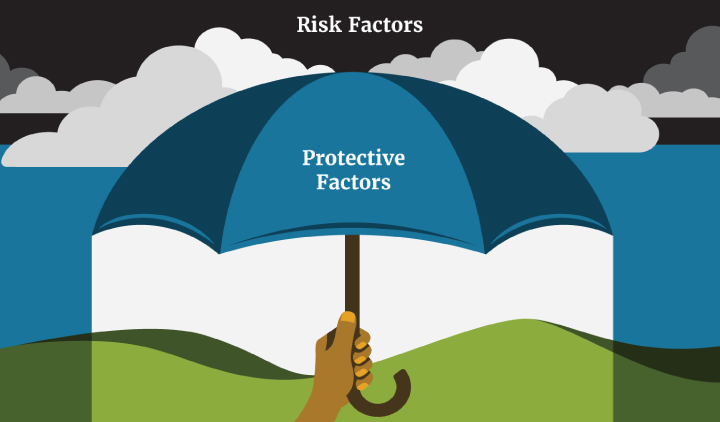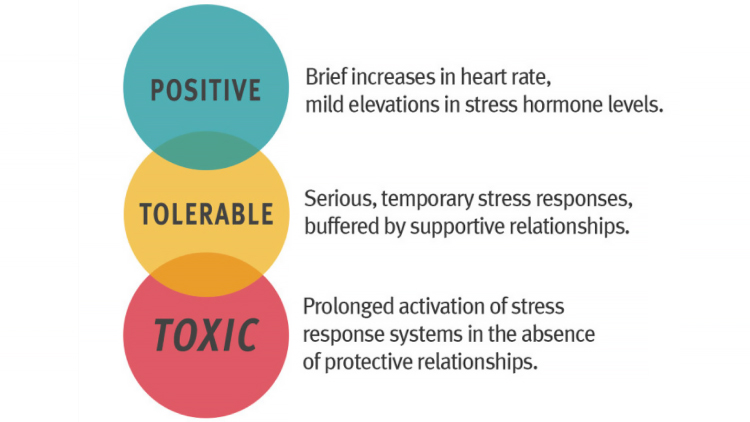TRAUMA-INFORMED PRACTICES
WHY DOES THIS MATTER?
Identifying protective and risk factors for substance use can assist school districts with developing and implementing strategies for substance use.
Prevention programs for substance use should focus on reducing risk factors and strengthening protective factors (SAMHSA, n.d.).
RISK FACTORS
Risk factors increase a person’s risk for poor outcomes. This can be behavioral characteristics, biological, environmental, or cultural level factors (SAMHSA, n.d.). For example, exposure to violence in the home or in the community are considered risk factors. Limited access to health care, family medical history, institutional racism, among others can increase a person’s risk for poor health outcomes.
PROTECTIVE FACTORS
Protective factors are “positive countering events” (SAMHSA, n.d.). This could include supportive relationships, healthy coping strategies, positive relationships with adults, and safe environments.
PUTTING THIS INTO PRACTICE
It’s important to note that some factors are “fixed” and do not change; while others are “variable” (SAMHSA, n.d.). These factors can be at the individual, interpersonal, and community level.
School districts can address risk factors and promote protective factors by establishing positive relationships with adults who are mentors; providing opportunities for families to engage in fun activities together; offering after school activities; enhancing community connectedness among students and ensuring safe, supportive environments on campus; and linking youth and families to necessary social and health services.
Source: Substance Abuse Mental Health Substance Administration
ACEs
ACEs & Trauma Informed Care
Risk factors increase the likelihood of adverse childhood experiences (ACEs); Trauma-informed practices are grounded in empathy to understand the root issue rather than reacting to the presenting behavior.
Risk factors increase the likelihood of adverse childhood experiences (ACEs) (CDC, 2021). ACEs specifically refers to the 10 categories of adversities in three domains experienced by age 18 years that were evaluated in the landmark 1998 study conducted among more than 17,000 adult patients by the Centers for Disease Control and Prevention (CDC) and Kaiser Permanente.
ABUSE
Physical, emotional, or sexual
NEGLECT
Physical or emotional
HOUSEHOLD CHALLENGES
Growing up in a household with parental incarceration, mental illness, substance dependence, parental separation or divorce, or intimate partner violence.
ACES CAN CAUSE TOXIC STRESS, WHICH IS EXTREME, FREQUENT AND DOES NOT GIVE TIME FOR RECOVERY.
A consensus of scientific evidence demonstrates that high doses of cumulative adversity experienced during critical and sensitive periods of early life development, without the buffering protections of safe, stable and nurturing relationships and environments, can lead to long-term disruptions of brain development, immune and hormonal systems and genetic regulatory mechanisms—a condition now known as the "toxic stress response" (ACEs Aware, 2021).
TRAUMA-INFORMED CARE
Trauma "results from an event, series of events, or set of circumstances that is experienced by an individual as physically or emotionally harmful or threatening and that has lasting adverse effects on the individual’s functioning and physical, social, emotional, or spiritual well-being" (SAMHSA, 2012, p. 2).
A TRAUMA-INFORMED APPROACH TO SUBSTANCE USE INCLUDES THE FOLLOWING COMPONENTS:
- A foundation grounded in trauma-informed principles and a teams approach.
- An environment that is calm, safe, and empowering.
- Education about the impacts of current and past trauma [and other adversities] on health.
- Inquiry about and response to recent and past trauma that includes onsite or community-based resources and treatments.
PUTTING THIS INTO PRACTICE
Becoming trauma-informed can also be described as a perspective shift. The perspective shift is moving from the belief that people are either inherently good or bad (traditional approach) and moving to an understanding that people are influenced to their social environment (trauma-informed), to ultimately understanding that people can overcome, heal and take control (resilience-building) (Dr. Ariane Marie Mitchell, 2018). Trauma-informed practices are grounded in empathy to understand the root issue rather than reacting to the presenting behavior.
EXAMPLES
- Build trust between school staff and students
- Student-centered, evidenced-based care
- Staff training
- After school programs
CULTURAL COMPETENCY
Culturally competent approaches to substance use improves quality of strategies and promotes better outcomes.
Cultural competence is defined as the "integration and transformation of knowledge about individuals and groups of people" that is integrated into "specific standards, policies and practices and attitudes" (CDC, 2021). Culturally competent approaches to substance use improves quality of strategies and promotes better outcomes. While this is not an exhaustive list, below are a few general cultural competency considerations when developing and implementing substance use strategies for students.
CDC'S PRINCIPLES OF CULTURAL COMPETENCE
- Define culture broadly.
- Value students’ cultural beliefs.
- Recognize complexity in language interpretation.
- Facilitate learning between providers (schools) and communities.
- Involve the community (students) in defining and addressing service needs.
- Collaborate with other agencies.
- Professionalize staff hiring and training.
- Institutionalize cultural competence.
PUTTING THIS INTO PRACTICE
- Establishing a committee or governing board to oversee cultural competence efforts.
- Incorporating cultural competence in strategic planning process.
- Completing a needs assessment to guide efforts.
- Reviewing and updating vision, mission and value statements.
- Evaluating commonly used substances in your community and learning about each substance’s subculture, and understanding that these can change.


